Psychosocial support- critical to education in Gaza

JERUSALEM-WESTBANK-GAZA - For many children around the world, psychosocial support and education do not go hand in hand. But for Palestinian children in South Gaza, psychosocial support is a necessary component to enabling a healthy learning environment. In Gaza, schools not only teach children but also help children to recover from the impact of conflict.
World Vision works with teachers in South Gaza to create both a comfortable and safe environment in which students, like 12-year-old Sulaiman can grow and become educated for life.
For years, Sulaiman, who lives in the refugee camp of Al Shaboura did very poorly at school and was violent towards his younger brother and friends. Sulaiman’s father received constant complaints from school teachers and neighbours about Sulaiman’s behaviour.
In South Gaza, psychosocial support is a necessary component to enabling a healthy learning environment
World Vision staff in South Gaza sought to engage Sulaiman in both remedial education and psychosocial support at the Future Generation Society Center, through its “Wellbeing of Children” and “Empowered Children” projects. According to Project Facilitator, Husam Baroud, Sulaiman’s aggression and performance at school came as a result of witnessing violence from the military conflict in Gaza and arguments within his own family. “When he first came to the center, he created an atmosphere of disorder and we could do nothing with him that day,” said World Vision Project Coordinator, Niveen Afana.
Sulaiman slowly improved- he was less aggressive with teachers and other children and was gradually moved to group sessions with children with similar needs. Suleiman’s English teacher, Hiam, said that the improvement in his performance is not coincidental. “This is a result of collaboration between teachers and social workers.” Sulaiman is now doing well in school and feels safer and happier.
This kind of support is needed by all children and families in the occupied Palestinian territory- particularly in Gaza. Forty percent of Gaza’s population is unemployed and about 80% of the population is completely reliant on foreign assistance.
Due to the blockade on Gaza, the education system continues to suffer from sub-standard school infrastructure and a shortage of classrooms. In addition to overcrowding, Palestinian children in Gaza face difficulties getting to and from school due to long distances between communities and their schools, as well as road closures and settler and military violence.
59.4% of primary school students and 69% of preparatory students did not feel safe going to and from school
According to the Ministry of Education and Higher Education, nearly 80% of government schools (311 out of 392) serving more than 230,000 students in Gaza operated on a double shift, with one school building used morning and afternoon for two separate schools. A UN psychosocial study also found that students experience anxiety, sadness and hopelessness because of the ongoing military violence and blockade in Gaza, resulting in difficulty learning, and 59.4% of primary school students and 69% of preparatory students did not feel safe going to and from school some or most of the time.
World Vision has 4,536 registered children in its South Gaza Area Development Programme, with 10,000 beneficiaries and as many as 50,000 indirect beneficiaries. World Vision works with communities in South Gaza to bring back hope into lives of children and families who are suffering under the illegal Israeli military occupation. Working in livelihood, education, and child protection, World Vision seeks to help improve family livelihoods and ensure children are cared for and protected.
World Vision is working with governments, local organisations and families to ensure the children of the world, including the children of Gaza, can enjoy good health, are educated for life, cared for, protected, participating, and experience the love of God and their neighbours.
Sources:
1) Central Intelligence Agency, The World Factbook, Gaza Strip, available athttps://www.cia.gov/library/publications/the-world-factbook/geos/gz.html. Last accessed on November 25, 2011.
2) Oxfam International, Crisis in Gaza, available athttp://www.oxfam.org/en/emergencies/gaza. Last accessed on December 9, 2011.
3) Save the Children UK, Child Rights in the Occupied Palestinian Territory 2010 Review, available at http://www.dci-palestine.org/sites/default/files/child_rights_review_20101.pdf. Last accessed on December 14, 2011.
4) Ministry of Education and Higher Education – Gaza Strip, Statistics for the academic year 2010/11.
5) UNESCO, Psychosocial Assessment of Education in Gaza and Recommendations for Response, Report on the findings of an assessment conducted by Kathleen Kostelny, PhD and Michael Wessells, PhD of the Columbia Group for Children in Adversity, September 2010. Available athttp://resourcecentre.savethechildren.se/content/library/documents/psychosocial-assessment-education-gaza-and-recommendations-response. Last accessed on December 14, 2011.